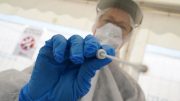One of the most effective methods to put the COVID-19 pandemic behind us is to stay ahead of it. And the past two years have demonstrated that we need to use every tool at our disposal to follow cases and, to the extent possible, predict when and where surges can develop.
One method, monitoring wastewater to trace the virus transmitted by sick people, has emerged as a promising way to do so. People infected with COVID-19 shed viral genetic material in their feces in a range of 40 to 80 percent of cases; studies have indicated that monitoring wastewater for evidence of SARS-CoV-2 can be an early predictor of when cases are rising, or even if a new variety is starting to dominate.
Because patients don’t get tested until they have symptoms, genetic sequencing of wastewater samples can reveal signals of virus days before testing results. According to Amy Kirby, program lead for the National Wastewater Surveillance System at the US Centers for Disease Control and Prevention, wastewater is a useful source of data because it passively collects so much data (NWSS).
«The data is unique in that it catches the presence of infections in persons with and without symptoms, and it is unaffected by access to healthcare or the availability of clinical testing,» she told reporters on February 4.
The COVID-19 Data Tracker at the CDC now has that information. It’s standardized, allowing individuals to compare data from different states or even counties. Those states and counties had been collecting and evaluating data on their own up until now.
Tracking SARS-CoV-2 in wastewater indicates virus upticks, which can assist communities to anticipate when cases start to rise and plan for the increased demand on hospital and community health services.
If virus levels in wastewater rise, for example, local health officials may send more mobile testing units to regions where infections are spreading, advising people on when and how to adopt stronger mitigation measures.
The CDC’s NWSS system was established expressly to monitor SARS-CoV-2 last September, according to Kirby; while the notion had been examined for years, COVID-19 was needed to validate the technology. The NWSS currently includes 37 states and four cities, all of which provide data to the network.
Hundreds more sites are expected to add their data in the coming weeks, according to Kirby. The CDC collaborates with municipal sewer sheds and health agencies to update data to reflect changes in virus levels over the previous 15 days.
Kirby points out that the tracking’s accuracy is only as good as the sampling locations’ depth. She believes that the stronger and more meaningful the trends will be as more sites join and give data.
«To enhance its utility, wastewater surveillance should be utilized in conjunction with case-based surveillance,» she said. «Cities and counties have already used wastewater surveillance to better understand the course of illness outbreaks.» The tool is now being used by many communities to aid in public health decision-making.»






Be the first to comment on "You Can Now Check How Much COVID-19 Virus Is In Your Community’s Sewage"